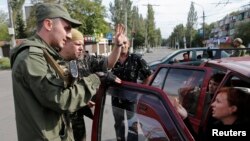DONETSK, Ukraine -- The website of the pro-Kyiv authorities in the eastern city of Donetsk features the photographs of dozens of local residents that have disappeared and are believed to be in the custody of the pro-Russian separatists that control parts of southeastern Ukraine around both Donetsk and Luhansk.
There are many ways to end up in a separatist jail -- being caught outside after curfew, failing to produce acceptable documents, or simply arousing the suspicion of one of the many masked men patrolling the streets with automatic weapons.
And, increasingly, one can end up there as a result of the old Soviet-style method of denunciation. More and more cases of people detained "under the testimony of neighbors" are being uncovered.
In October, a document appeared on social media that purported to be a denunciation form from the separatist authorities of Donetsk that people could use to report about "a citizen who is not worthy of occupying the honored position of a citizen of the DNR [Donetsk People's Republic] and needs to be isolated" and who "carried out illegal activities not in correspondence with the general policies of the Donetsk People's Republic and the interests of our country."
The photographed document accused a local whose name was obscured of insulting two DNR functionaries, calling for the "physical destruction" of the DNR leadership, and "offending those who support the idea of the DNR."
At around the same time, another denunciation raised eyebrows in Luhansk. In this instance, it came from the separatist, self-proclaimed "culture minister," Irina Filatova.
"I ask you to take measures to detain and punish according to martial law Yelena Vladimirovna Krasnovskaya...," Filatova says in a letter. She goes on to claim that Krasnovskaya "performed rituals" at a city cemetery that were intended to "weaken the statehood of the Luhansk People's Republic [LNR] and bring harm to the health of its citizens."
"According to the testimony of neighbors, she supports the Kyiv junta and is set against the LNR and Donbas," the denunciation continues. "I request that you investigate the incendiary activity of Ye. V. Krasnovskaya and determine a just means of punishment, including execution by shooting according to the regime of martial law."
Last month, a businesswoman from Donetsk named Svitlana Matushko told RFE/RL that she spent one week in captivity in Donetsk after a man she had been dating denounced her for allegedly reporting on separatist militia positions to the Ukrainian military.
Ukraine's Interior Ministry recently released a statement from a Donetsk resident identified only as Dmytro, who told of a 27-year-old neighbor who got into a dispute with another neighbor over some money that she borrowed.
The conflict led to a loud argument in front of the building one day in July, Dmytro claims, in which the woman's father sided with the neighbor and asked his daughter to repay the debt.
"On the next day, two cars without license plates pulled up to our building," Dmytro's statement reads. "The woman got out of the first car and some guys from DNR got out of the second. After a little while, they brought out the neighbor and the father in handcuffs, pushed them into the back of the cars and drove off. We didn't see them again."
Dmytro adds in his statement that he supports the DNR, although the incident in his building disturbed him.
Such occurrences appear to have eerie echoes of the Stalinist era of terror in the former Soviet Union, where preemptive accusations were commonplace.
Wendy Goldman, a professor of history at Carnegie Mellon University and author of "Inventing The Enemy: Denunciation And Terror In Stalin's Russia," argues that the tactic played a major role in intensifying and spreading fear and repression under Stalin.
In a 2011 interview about her book, Goldman argued that "ordinary Soviet citizens participated widely and actively in the Terror."
"These behaviors were motivated by genuine belief in alleged enemies, by fear of exposure or attack, and in many cases by both," Goldman said. "Faith in and fear of the state operated at the same time and often were intertwined in the responses of the same person. Many of the strategies that people used to protect themselves increased the risk to others and help spread the terror."
-- Ilya Trebor, with contributions from Robert Coalson
